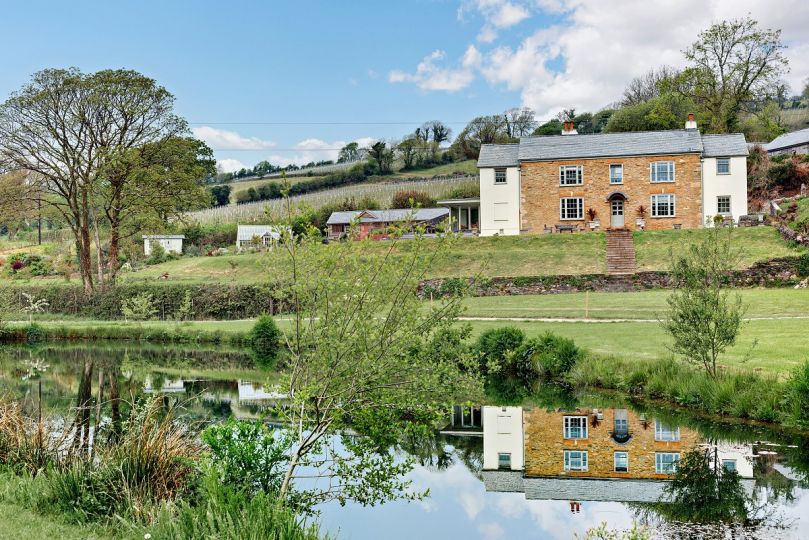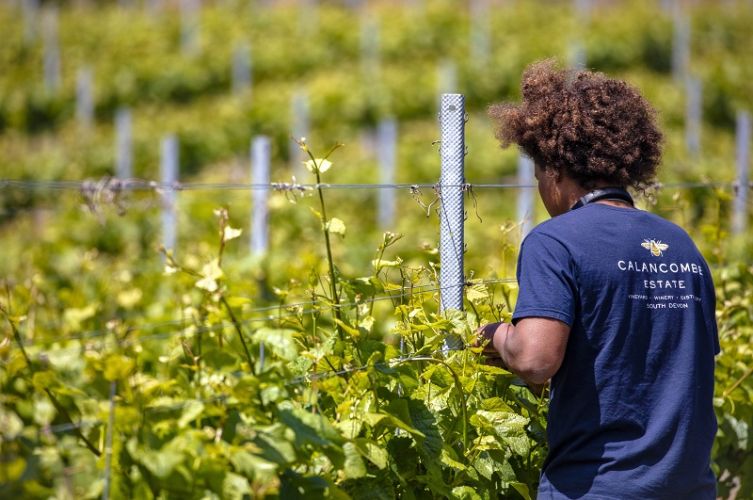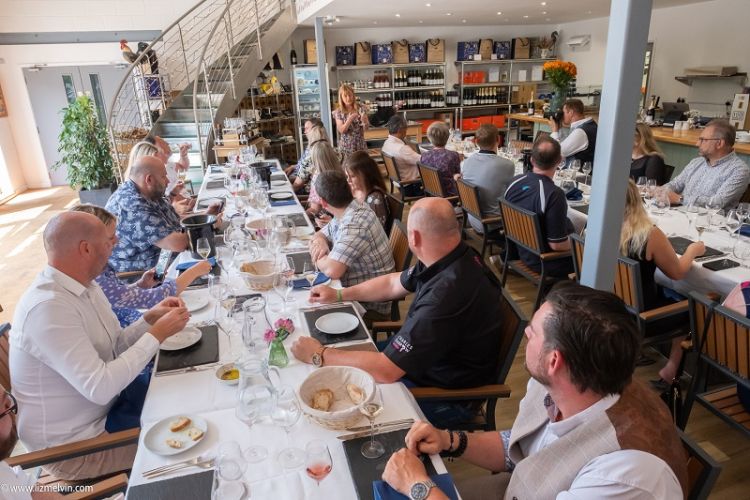
Client Stories: From derelict farm to award-winning vineyard and distillery

Located between Dartmoor National Park and a sought-after stretch of south Devon coastline is an idyllic private estate.
This extraordinary 56-acre farm, known as Calancombe Estate, is home to an acclaimed vineyard and winery, distillery, restaurant and cellar door shop.
Although relatively new, Calancombe has already scooped up numerous prestigious awards, including those from Wine GB, Independent English Wine Awards, Taste of The West Gold Awards, Great Taste (one and two star awards), and Food and Drink Devon Gold Awards.
It has also been awarded Small Visitor Attraction of the Year in Devon and third overall for the whole of the South West as well as Classic Gin of the Year at the Craft Distilling Expo.
This is testament to the extraordinary passion, and vision of owners, Lance and Caroline Whitehead.

Establishing the vines
The estate took root about 12 years ago when the Whiteheads bought a derelict farm in the picturesque South Hams with the intention of making it their home.
The couple already had their hands full. Lance, who started out in the Royal Air Force Regiment, is in the private equity fundraising business, while Caroline is a corporate lawyer.
Encouraged by the south-facing slopes, free-draining soils, and microclimate, the couple planted 5,800 Pinot Noir vines in 2012.
Over the years that followed, they bought more land and planted 3,400 Bacchus, 1,100 Pinot Gris, 3,900 Madeleine Angevine, 2,000 Pinot Noir Précoce, 1,000 Chardonnay, and 2,250 Ortega, culminating with 3,500 Pinot Noir in 2022.
“Caroline is a wine fanatic; she has a forensic sense of taste and smell and an encyclopaedic knowledge of wine. I think she's always harboured the desire to have a vineyard, so it was not surprising that her thoughts turned to a vineyard. We had the land, and the location is ideal for a vineyard, so it developed naturally.” Lance explains.
Vines are now planted across more than 23 acres, which produce still and sparkling, white and rosé wines. The entire production process is undertaken at Calancombe, from picking the grapes, right through to making, bottling and labelling the wine.

Branching out
But the Whiteheads didn’t stop there. They also planted more than 1,500 cyder apple trees as well as damson and Mirabelle trees, and 3,000 blackcurrant bushes. These form the basis of their still and sparkling cyder, brandy and cassis.
Lance says: “I've planted every single one of the apple trees myself, so it has been a very personal journey, but very special. It's hard work. But there's something magical about apples and apple trees.”
While the vines and trees developed, the couple diversified further. Spearheaded by Lance, they branched out into gin.
It was born out of his interest in the spirit: “I've always loved gin so it’s just a desire to create something special, which we believe we've done.”
It was also a savvy move: “If you're a small business, you need to have more than one product,” Lance explains. “If you have a bad year in the vineyard which you have no control over, such as too much rain, you have no crop. So, it is very much a matter of diversifying the business to make it more resilient.”
The Whiteheads bought a 230-litre copper still from Müller Brennereianlagen in the Black Forest, Germany. This paved the way for their flagship product, Dartmouth English Gin, and Dartmouth Navy Strength Gin, named after the naval town nearby.
Lance says: “We started to build brand awareness of Dartmouth Gin and the distribution network that we established with the gin was the first network we started selling the wine into. It was very successful because of that.”
Opening the doors to visitors
The Whiteheads then took Calancombe one step further and opened it up to the public, with a visitor centre providing a focal point.
Today, visitors can go on tours of the vineyard and orchards, enjoy tastings in the winery, dine on fresh produce in the Restaurant, and buy Estate wines and spirits at the Cellar Door shop.
There’s a Gin School too, where up to 20 visitors can create their own gin using copper stills. Plus, there’s space to host private events, such as parties and business gatherings, for up to 60 people seated.

Team behind the scenes
At the heart of Calancombe is a loyal team who “work immensely hard” across the estate, says Lance.
“Our Team are almost all retired or semi-retired professionals. They're bright and enthusiastic and they take great pride in everything they do. They arrive with a bounce in their step because they love being part of something special,” he explains.
Residential properties
As well as the commercial enterprise, Calancombe Estate has 3 beautiful residential properties, of which one is Lance and Caroline’s home. They live in a five-bedroom Georgian farmhouse on the estate, which they renovated impeccably. At the back is a courtyard that leads to a gym, shower room and office, as well as a boiler and plant room. This could be converted into residential, subject to planning consent.
There are two further properties: a six-bedroom converted barn with an indoor swimming pool and cinema and a one-bedroom cottage. Together, they form a south-facing, three-sided courtyard.
It is a truly bucolic setting, complete with a trout stream, ponds, and several paddocks.
Yet Calancombe is still well-placed for transport. It’s located just four miles from the A38, a key route in Devon, linking Exeter and the M5 with Plymouth and Cornwall.
Calancombe’s next chapter
Having cemented Calancombe’s reputation as a leading producer and visitor destination, the Whiteheads have decided the time is right to sell the estate.
“We are enjoying being totally engaged and immersed in what we do, but I don't want to do it to my dying day. More importantly, I want to be nearer to my family,” says Lance, who is approaching 70 years old.
“We've achieved a lot here and we're very proud of what we've done. But like most people, at some point, one wants to retire and change gear.”
Whoever steps into their shoes has a unique opportunity to take Calancombe to the next level.
The vineyards go from strength to strength. The harvest in 2023 created 30,000 bottles of wine. This could rise to around 45,000 bottles each year when the Pinot Noir that was planted in 2022 comes into fruition.
Similarly, there’s scope to further develop still and sparkling cyder, brandy and cassis as the orchards grow.
And, of course, there’s Calancombe’s award-winning gin and hospitality operations too.
“This is an opportunity to take over a successful and still-growing going concern,” explains Lance.
“The estate has two beautiful family homes. So, it would be ideal for two partners or two families who wanted to take on a wine-making business, distillery and everything else without the gestation period of 10 years before it becomes fully productive.”
